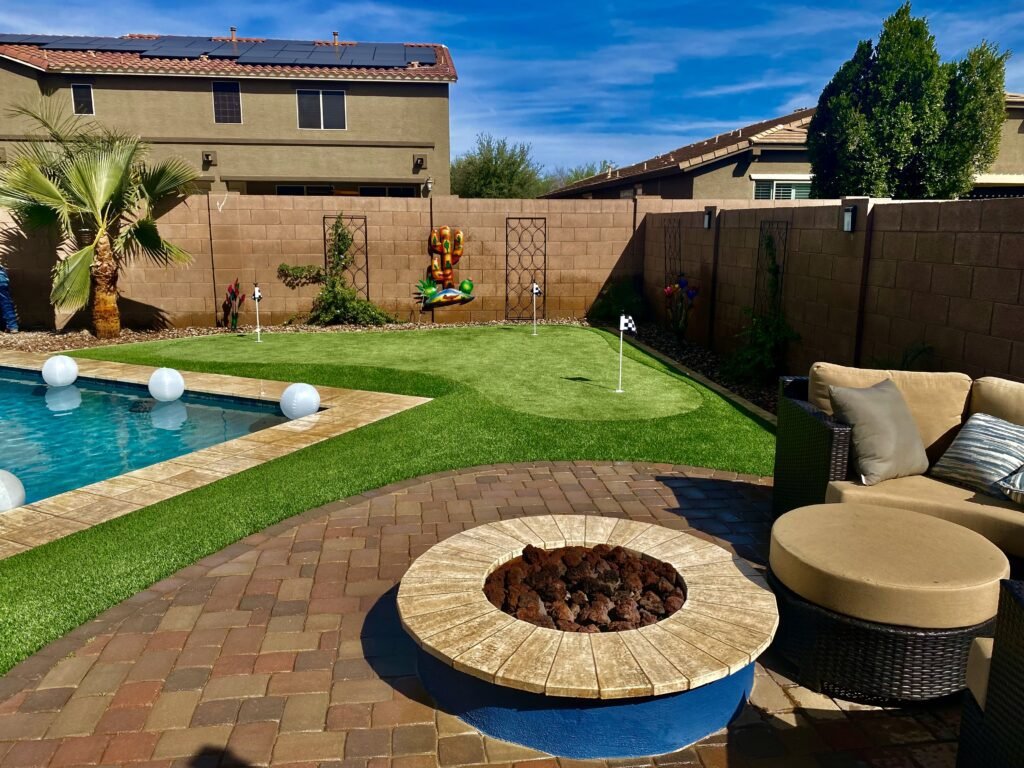Intro
Putting is often considered the most crucial aspect of golf, as it can significantly influence your overall score. Whether you are a beginner or an experienced golfer, refining your putting skills can lead to substantial improvements in your game. This article will provide you with comprehensive tips, drills, and practice routines to enhance your putting. Additionally, we will explore the benefits of practicing at home, on a synthetic turf putting green, specifically those designed by All Valley Turf, which offer a realistic experience without the maintenance demands of natural grass.
Tips for Effective Putting
- Proper Stance and Alignment: Your stance should be comfortable and balanced, with your feet shoulder-width apart. Ensure your eyes are directly over the ball, and your shoulders, hips, and feet are aligned parallel to the target line. This alignment helps in maintaining a consistent stroke.
- Grip and Stroke: Use a light grip to maintain a smooth and controlled stroke. The putter should move in a pendulum-like motion, with minimal wrist movement. Focus on keeping your stroke straight and consistent.
- Reading the Green: Understanding the slope and grain of the green is essential. Take time to read the green from multiple angles to determine the break and speed required for your putt.
- Pace Control: Controlling the pace of your putt is crucial. Practice hitting putts of varying lengths to develop a feel for different speeds. Remember, a putt that is too fast or too slow will miss the hole, regardless of the line.
Drills to Improve Your Putting
- Yardstick Drill: Place a yardstick on the ground and practice putting along its length. This drill helps in maintaining a straight stroke and ensures that the ball starts on the intended line.
- Cup Drill: Place a small cup or target on the floor and practice putting towards it. This drill improves your accuracy and helps you focus on hitting a specific target.
- Gate Drill: Set up two tees slightly wider than the width of your putter head. Practice putting the ball through the gate without touching the tees. This drill enhances your alignment and stroke consistency.
- Clock Drill: Place balls around the hole at different positions, resembling the numbers on a clock. Practice putting from each position to improve your accuracy and confidence from various angles and distances.
- Distance Control Drill: Place a club or alignment stick a few feet behind the hole. Practice putting from different distances, aiming to stop the ball either in the hole or just past it without hitting the stick. This drill helps in developing a feel for distance control.
Practice Routines
- Warm-Up Routine: Start your practice session with short putts (3-5 feet) to build confidence. Gradually increase the distance as you become more comfortable. Spend at least 10-15 minutes on this routine to establish a solid foundation.
- Focused Practice: Dedicate specific time to each drill mentioned above. For example, spend 10 minutes on the yardstick drill, followed by 10 minutes on the cup drill, and so on. This focused practice helps in addressing different aspects of your putting game.
- Simulated Pressure: Create a pressure-filled environment by setting goals for your practice session. For instance, challenge yourself to make 10 consecutive putts from a specific distance. This routine helps in building mental toughness and prepares you for real-game situations.
The Advantage of Synthetic Turf Putting Greens
Practicing on a synthetic turf putting green offers numerous benefits. All Valley Turf provides high-quality synthetic putting greens designed by an actual PGA Professional, ensuring a realistic and professional practice experience. Here are some advantages of using synthetic turf:
- Consistency: Synthetic turf provides a consistent surface, allowing you to practice your putting with the same conditions every time. This consistency helps in developing a reliable stroke and improving your overall performance.
- Low Maintenance: Unlike natural grass, synthetic turf requires minimal maintenance. You do not need to worry about mowing, watering, or dealing with uneven surfaces. This convenience allows you to focus solely on your practice.
- Durability: Synthetic turf is highly durable and can withstand heavy use without showing signs of wear and tear. This durability ensures that your putting green remains in excellent condition for years, providing a long-term investment in your game.
- Realistic Feel: All Valley Turf’s synthetic putting greens are infilled to replicate the feel and performance of natural grass. This realistic experience helps in transferring your practice skills to the golf course seamlessly.
- Customization: All Valley Turf offers customized putting greens tailored to your specific needs and preferences. Whether you want a simple practice area or a complex green with multiple undulations, they can design and install the perfect solution for you.
Conclusion
Improving your putting skills requires dedication, practice, and the right techniques. By incorporating the tips, drills, and practice routines outlined in this article, you can enhance your putting performance and lower your scores. Additionally, practicing on a synthetic turf putting green from All Valley Turf provides a consistent, low-maintenance, and realistic environment to refine your skills. With putting greens designed by a PGA Professional, you can trust that you are getting the best possible practice experience. Invest in your game today and see the difference that quality practice can make.
For more information on All Valley Turf’s synthetic putting greens, visit their website or contact their team of experts. Start your journey towards becoming a better putter and enjoy the benefits of a professional-grade practice facility right in your backyard.


